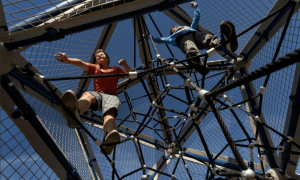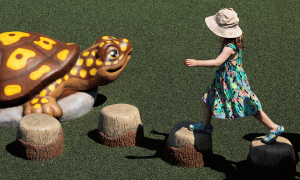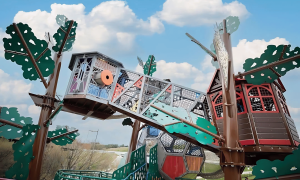 We recently talked with Brandon McBride, GameTime's Vice President of Design, about how our Landmark Design team works with landscape architects. Brandon shared his thoughts on the importance of designing a play and recreation area that appeals to all generations. He also elaborated on the key role landscape architects play in making playgrounds a centerpiece of the community.
We recently talked with Brandon McBride, GameTime's Vice President of Design, about how our Landmark Design team works with landscape architects. Brandon shared his thoughts on the importance of designing a play and recreation area that appeals to all generations. He also elaborated on the key role landscape architects play in making playgrounds a centerpiece of the community.
Read on and learn how GameTime and landscape architects work together to enrich childhood and build communities through play.
What drives your creative process when working with landscape architects?
What is the primary inspiration for how you design a play area together?
One of the main drivers is envisioning how children will utilize the space. We work with landscape architects to incorporate elements that create positive challenges and spark the imagination. That’s a critical component to the success of each play space.
Understanding how children use the area provides a foundation to create a design that facilitates social interaction between peers. Each of us has a fundamental desire to build connections with those around us. A playground is great for a child’s physical development, but it’s also essential for enriching their social, cognitive, and emotional capacity as well.
What types of products and materials do landscape architects gravitate toward?
What drives the decision to use them?
As a landscape architect, GameTime’s Landmark Design team views each project individually and considers the materials or products that will best complement that space. The utilization of custom concrete elements helps build durable spaces with rich texturing. It can also provide a connection to a unique theme or story.
Some spaces lend themselves to a more modern style or advanced levels of play. Selecting the right components and materials is essential to a positive user experience and achieving the community's desired outcomes.
What has changed most about playground design?
How have people changed the way they use playgrounds in the past 5 or 10 years?
One of the most critical shifts in playground design is a thoughtful process toward a multi-generational design philosophy. Playgrounds have shifted from a fringe recreation area to a central community space. There is evidence parents want to engage with their children during play, and communities understand play environments are critical anchor points where people come together and gain a stronger sense of community at every age.
In playground design today, is it just the children who will play on the equipment?
Do you consider other family members/generations?
It is essential to consider all the users that may utilize the space. Each individual has to be comfortable in the environment. We want people to spend as much time in the space as possible so they can enjoy all the benefits (physical, social-emotional, cognitive, etc.) of the design. If someone has a positive experience, they are more likely to come back again and again.
At the beginning of any project, we also consider making a play area accessible and inclusive to the greatest extent possible. I want every space to offer something for everyone, regardless of age or ability. Parents and grandparents need spaces to interact with their children, grandchildren, and peers playfully.
We also look for areas to include comfortable seating to gather, socialize and observe play. By considering how everyone will use a playground, it becomes a vital community centerpiece that impacts a broader cross-section of the community.
Why is thoughtful and creative design important to a playground?
What are the added benefits for the users when you take the time to design something out of the ordinary?
Working with different communities across North America and leading landscape architects helps our designers flex their creative muscles and create better and unexpected designs. Creating something new and unexpected engages children and families to play, explore, and grow together.
A thoughtfully designed play area attracts people, encourages physical activity, and enhances childhood development. It breaks down barriers and brings people together. Ultimately, playground design helps people connect, forge lasting relationships and create memories that last a lifetime.
Let's Design Something Extraordinary Together
If you're planning a park, playground, or other recreation space for people of all ages and abilities, we'd love to talk with you. Our team of designers, architects, and engineers use a collaborative process to ensure every project meets a community's goals and exceeds their expectations. Contact the GameTime play expert in your neighborhood to learn more.
- Trails (27)
- Schools (191)
- Press Releases (109)
- Playground Funding (5)
- Play Science & Research (62)
- Parks & Recreation (360)
- Outdoor Fitness (138)
- National Demonstration Site (32)
- Landscape Architects (77)
- Inclusive Play (109)
- Daycare and Early Learning (62)
- Custom Play (38)
- College Campus (28)
- Churches (51)
- Challenge Course (30)
- Featured Projects (77)
- BluePrint for Play (18)
- Site and Shade (9)





